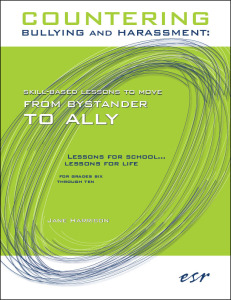 To help middle and high school educators access high-quality resources that will help them support students to recognize, resist, and address bullying and harassment, we’re following up on last week’s overview of Countering Bullying and Harassment: Skill-Based Lessons to Move from Bystander to Ally. Countering Bullying and Harassment, our pro-social, anti-bullying curriculum for sixth through tenth graders, shares an approach for building competency and commitment among early adolescents to counter bullying and harassment that was developed over the course of many years within our organization and field tested in collaboration with six middle schools in Massachusetts.
To help middle and high school educators access high-quality resources that will help them support students to recognize, resist, and address bullying and harassment, we’re following up on last week’s overview of Countering Bullying and Harassment: Skill-Based Lessons to Move from Bystander to Ally. Countering Bullying and Harassment, our pro-social, anti-bullying curriculum for sixth through tenth graders, shares an approach for building competency and commitment among early adolescents to counter bullying and harassment that was developed over the course of many years within our organization and field tested in collaboration with six middle schools in Massachusetts.
The field testing gave us valuable feedback that informed the structure of Countering Bullying and Harassment‘s six lessons per grade. The lessons have been written in a “workshop structure,” which encourages a facilitative style of teaching and creates a sense of community structure with a positive influence extends beyond the scope of the lesson. Each lesson includes:
Gathering (usually 3 – 5 minutes)—An experiential activity or sharing that relates to the main purpose of the lesson and helps students focus on the learning to come. Gatherings are intended to be positive, community-building experiences.
Agenda Review (3 – 4 minutes)—A brief review of what will happen during the lesson that lets students know what to expect. It is most helpful when the Agenda is written on the board or on chart paper.
Main Activities (from 10 – 20 minutes)—Whole class or group activities that provide structured situations that focus on the lesson’s subject. Some lessons have more than one activity.
Debriefing (3 – 5 minutes)—A recap that helps students review and internalize what has occurred. It is most important that a debriefing occur, even if activities need to be streamlined due to time. Without the opportunity for students to make meaning out of the material, they might not see the relevance of what has been discussed to their own lives.
Closing (2 – 5 minutes)—A quote or exercise to provide closure to the lesson.
So that you can see this in action, we’ve posted Lesson 1 for each grade level; click here for this free download. For an overview of all six lessons for grades six through ten, take a look at the overall lesson grid.
We’ve structured the lessons so that they can work in a wide variety of settings in which adolescents and adult learning facilitators have time and trust. Classroom teachers in academic subjects have found that beginning the year with pro-social activities helps to start the year on a positive note, and as a support to integration in an academic setting, we’ve provided a guide to assessing student learning and ELA Common Core alignment. However, there are many other implementation possibilities: advisory, youth leadership programs, new school orientation, freshmen seminars, health education classes, humanities classes, special workshops for students, and out-of-school time youth programs. These lessons can also become a vital part of a peer education program.
Next, we’ll consider factors that help educators and school leaders to determine whether their classroom or school’s conditions will properly support a program that helps students to identify, resist, and address various forms of bullying and harassment.
—
Please click here for more information about Engaging Schools’ Countering Bullying and Harassment: Skill-Based Lessons to Move from Bystander to Ally.
- Topics
- Advisory Plus (3)
- Annual Reports (1)
- Blog (66)
- Conferences (3)
- Countering Bullying and Harassment (4)
- Development (1)
- District Codes of Character, Conduct, and Support (2)
- Engaged Classrooms (11)
- Engaging Schools (12)
- Publications (8)
- Research (5)
- Schoolwide Discipline and Student Support (23)
- Social and emotional learning (10)
Twitter Feed





